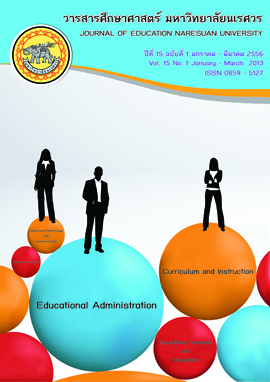กลยุทธ์การพัฒนาระบบประกันคุณภาพภายในสถานศึกษาขั้นพื้นฐาน สังกัดสำนักงานเขตพื้นที่การศึกษาประถมศึกษากำแพงเพชร เขต 1 และเขต 2
Main Article Content
Abstract
บทคัดย่อ
การวิจัยนี้มีวัตถุประสงค์เพื่อ 1) ศึกษาสภาพ ปัญหาและความต้องการเกี่ยวกับระบบประกันคุณภาพภายในสถานศึกษาขั้นพื้นฐาน 2) พัฒนากลยุทธ์การพัฒนาระบบประกันคุณภาพภายในสถานศึกษาขั้นพื้นฐาน และ3) ประเมินกลยุทธ์การพัฒนาระบบประกันคุณภาพภายในสถานศึกษาขั้นพื้นฐาน ดำเนินการ 3 ขั้นตอน คือ 1) ศึกษาสภาพ ปัญหาและความต้องการ โดย (1) การถามความคิดเห็นผู้บริหาร 187 คน และครู 344 คน (2) การสนทนากลุ่มผู้บริหารและครู 20 คน 2) พัฒนากลยุทธ์ฯ โดย (1) ประชุมเชิงปฏิบัติการผู้ทรงคุณวุฒิ 30 คน(2) การสัมมนาอิงผู้เชี่ยวชาญวิพากษ์ร่างกลยุทธ์ฯ 9 คน 3) ประเมินกลยุทธ์ฯ ด้านความสอดคล้อง ความเหมาะสมความเป็นไปได้ และความเป็นประโยชน์ โดยผู้เชี่ยวชาญ 19 คน ผลการศึกษาวิจัยพบว่า
1. สภาพความ ปัญหา และความต้องการ พบว่า สถานศึกษาดำเนินงานที่มีลักษณะเป็นงานที่ต้องดำเนินงานตามแนวปฏิบัติที่ระบุไว้อย่างชัดเจน ปัญหาในภาพรวมอยู่ในระดับน้อย ส่วนความต้องการในภาพรวมอยู่ในระดับมาก โดยต้องการพัฒนาผู้บริหารและครูให้เห็นความสำคัญของการประเมินคุณภาพภายในตามมาตรฐานการศึกษา มากที่สุด
2. กลยุทธ์การพัฒนาระบบประกันคุณภาพภายในสถานศึกษาขั้นพื้นฐาน มี 7 กลยุทธ์ ได้แก่ 1) เพิ่มศักยภาพของบุคลากรในด้านการประกันคุณภาพภายในสถานศึกษาและภาระงานที่รับผิดชอบ 2) พัฒนาระบบข้อมูลสารสนเทศการประกันคุณภาพภายในโดยใช้เทคโนโลยี 3) เพิ่มประสิทธิภาพของกระบวนการประกันคุณภาพภายในสถานศึกษาขั้นพื้นฐาน 4) ปรับวิธีการทำงานโดยเชื่อมโยงงานประจำกับงานประกันคุณภาพภายในสถานศึกษาขั้นพื้นฐาน 5) ปรับปรุงกระบวนการประเมินผลระบบประกันคุณภาพภายในของสถานศึกษาขั้นพื้นฐาน 6) ส่งเสริมการติดตาม ประเมินผลปัจจัย และกระบวนการดำเนินการระบบประกันคุณภาพภายใน 7)พัฒนางานตามภารกิจของสถานศึกษาให้มีคุณภาพตามมาตรฐานอย่างต่อเนื่องเป็นวัฒนธรรมองค์กร
3. ผลการประเมินความสอดคล้อง ความเหมาะสม ความเป็นไปได้ และความเป็นประโยชน์ของกลยุทธ์โดยภาพรวม พบว่า มีความสอดคล้องในระดับมากที่สุด มีความเป็นไปได้ในระดับมาก มีความเหมาะสมและความเป็นประโยชน์ในระดับมากที่สุด
Abstract
The objectives of this research were to 1) study the state, problems and needs of theinternal quality assurance system of primary schools, 2) develop the strategies for internalquality assurance system, and 3) assess the development strategies of internal qualityassurance system. The research procedure comprised three phases: 1) studying the state,problems and needs of the internal quality assurance system in primary schools by (1)interviewing 187 administrators and 344 teachers (2) using focus group with 20 schooldirectors and teachers, 2) developing the strategy by (1) using 30 expertises’ workshop (2)providing a seminar for 9 expertises, and 3) assessing the consistency, propriety, feasibility, andutility of the development strategy by 19 experts.
Result of the study:
1. The state, problems and the needs were evaluated and found that the primaryschools had to follow their explicit missions according to the instruction guideline. The overallproblem conditions were at a low level. The demand aspect was high as a whole by improvingthe school directors and the teachers to realize the importance of internal quality assurancesystem most.
2. Strategies for Internal Quality Assurance System of Primary Schools UnderKamphaengphet Primary Educational Service Area Office 1 and 2 consisted of 7 strageties,e.g. 1) Increasing human resource capacity to meet the standards of education and support forquality assurance and responsibilities, 2) Developing the internal quality assurance byemploying the information technology system, 3) Increasing the efficiency of internal qualityassurance in Primary School within Basic Education Commission, 4) Adjusting the worksystem connecting to the routine work and internal quality assurance 5) Improving theevaluation of internal quality assurance process system 6) Supporting and evaluating thefactors and internal quality assurance process system, 7) Developing the schools’ missions tobe standard and continual as an organization culture.
3. The result of strategy’s consistency, suitability, feasibility, and utility assessmentfound that the strategy’s consistency was at the highest level, the suitability was at a highlevel, and the feasibility and utility were at the highest level respectively.
Article Details
The owner of the article does not copy or violate any of its copyright. If any copyright infringement occurs or prosecution, in any case, the Editorial Board is not involved in all the rights to the owner of the article to be performed.


